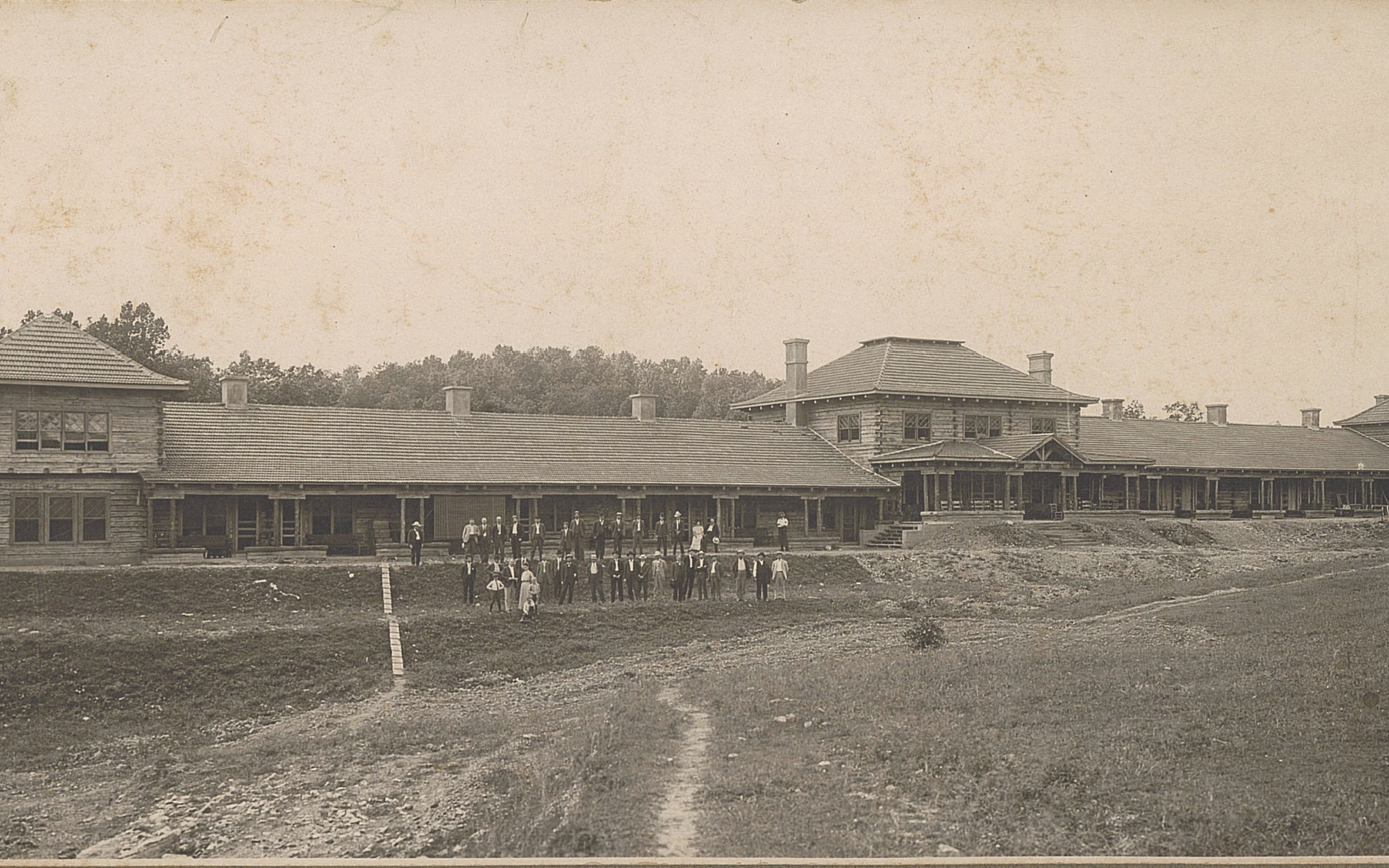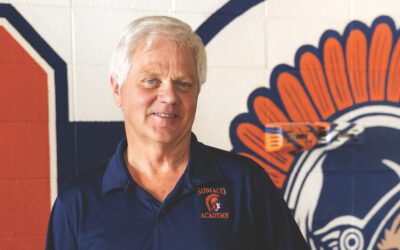William Hope “Coin” Harvey first laid eyes on Northwest Arkansas when he was campaigning for the 1896 Democratic nominee for president, William Jennings Bryan. Bryan was thirty-six at the time, a young and enthusiastic candidate. Harvey was forty-five years old, an accomplished man with big aspirations and even bigger opinions.
The nation had weathered hard economic times, and Bryan’s following believed he was the best hope for financial stability. In 1873, the U.S. adopted the gold standard and abandoned the silver dollar as legal tender. Bryan and the Free Silver Movement wanted the monetary system to be based on both silver and gold.
The issue divided voters. Harvey, who agreed with Bryan, saw the debate as a symbol of a bigger problem. We were a nation of (silver) people who worked hard and produced tangible things, such as farmers with their crops. But we were also a nation of (gold) people whose hands never got dirty, whose backs never ached. They made money through financial endeavors such as banking and lending. They made money because they had money.
At the Democratic convention, Bryan spent three hours giving a speech called “Cross of Gold.” In it, he said, “You shall not press down on the brow of labor this crown of thorns. You shall not crucify mankind on a cross of gold.” He could have been an evangelist, warning sinners against the fires of hell, such was his passion on the subject.
It must be noted that Harvey once owned a silver mine in Colorado called the Silver Bell. His mining might have set him up for the rest of his life had it not been for the declining value of silver, as well as an influx of new mines in the area.
Harvey was not shaken by setbacks. He’d failed before in Utah, when he tried to pull off an elaborate, first-time-ever Mardi Gras celebration, which ended with guns drawn and lawsuits against Harvey. But he’d also built the successful Mineral Palace, an impressive building which housed a selection of the state’s mineral resources, in Pueblo, Colorado. There was even an eleven-thousand-pound sculpture of “King Coal.”
At nineteen years of age, he’d become an attorney. At twenty-three, he’d designed and built a New Orleans-style house on Society Row in Huntington, West Virginia, so architecturally pleasing it was put on the National Register in the 1970s.
So, the silver mine failing, while disappointing, was nowhere near the end of Harvey’s story. Instead, he set up a publishing company in Chicago and tried his hand at writing about the Free Silver Movement. He could certainly turn a phrase. In 1894, he published Coin’s Financial School, using a literary device that employed a fictional character named Coin. The young protagonist laid out his case for Free Silver in exceedingly simple terms.
The masses loved it. And Harvey got stuck with a nickname, Coin.
Unfortunately for Harvey, Bryan didn’t win the presidential election of 1896. (Bryan would later serve as prosecutor for Tennessee, facing defense attorney Charles Darrow in the famous 1925 Scopes trial).
But back to the presidency. It went to William McKinley. So, no silver lining for Harvey, at least not in the political world. But he remembered the hills and valleys, the lakes and streams, the farmland and orchards of Northwest Arkansas.
Good people lived there. Salt of the earth people. People who breathed dew-kissed air in the morning, planted crops underneath a glowing sun, and dipped their toes in the crystal waters of the Natural State.
Harvey wanted to be part of that.
If he were a different man, he might have bought a few acres and kept it pristine, save for building a house and a barn for his family. Maybe plant an apple grove, since apples were a bustling part of the local economy. But Harvey was a developer. He found three hundred twenty acres for sale in Silver Springs, southeast of Rogers. (An aside: Silver Springs was home to Will Rogers’ wife, Betty Blake Rogers.)
Harvey looked at the land and saw possibilities: hotels, a railroad, an indoor swimming pool, and a newspaper. Intellectuals and philosophers would come to share their views. The best people would visit, and Harvey’s considerable influence on the culture would continue. He’s said to have raised fifty thousand dollars and contributed fifty thousand of his own. The year was 1900.
It’s curious he didn’t keep the village’s name, Silver Springs, since the title carried the very precious metal he’d loved so well. He changed the name to Monte Ne, which he claimed combined a Native American and a Spanish word that, when put together, translated to mountain water.
Many have questioned his interpretation. They have called the name Monte Ne malarkey, a fantasy, a fiction. History has shown Harvey to be an embellisher, the slickest of slick salesmen. Good stories sell, and Harvey was a fine storyteller.
Back in Chicago, Harvey had a family, including his wife, Anna. If Anna had had the equivalent of social media, she most likely would have listed her relationship status as “complicated.”
To get his family to Arkansas, Harvey needed to build a big enough house, and so he did. Sometime after it was finished, his wife and children arrived. Not long after, the house caught fire, a disaster that must have been the last straw for Anna. Historians have written about this time, noting that the Harveys had a parting of the ways. Anna took the children back to Chicago, except for sons Halliday and Tom. The couple divorced in 1929.
Halliday must have been a great help to his father. A veteran of the Spanish American War, he’d fought in Cuba, where hunger and malaria made the battle even worse. He’d seen the toughest parts of life. In Monte Ne, Halliday worked promoting and managing the resort, and in 1901, along with his uncle, Ernest Halliday, he opened Arkansas’ first indoor pool and bathhouse, another feather in Harvey’s cap.
We don’t know exactly what Harvey’s relationship with Halliday was like, but it’s clear he loved him. In 1903, Halliday was working on a train that was traveling in Oklahoma. There was an accident, and Halliday was killed. He was twenty-three or twenty-four years old.
An easy assumption would be that Halliday’s death was a loss that grieved Harvey for the rest of his life. In the years to come, he’d grow increasingly pessimistic, fearing that the world as he knew it was doomed.
What we do know are the facts. When Halliday died, Harvey ordered a massive concrete mausoleum to be built. It sat on a tranquil hillside in Monte Ne, overlooking the lake. The mausoleum reportedly weighed forty tons and had space reserved for Harvey’s body, once he’d joined his son in death. There was also space for Harvey’s beloved books and writings.
Whatever lay ahead, Harvey could be certain his final resting place would be on that quiet hill with his boy, Halliday. But a strange turn of events would change even that, although, of course, he didn’t know it at the time. And so, Harvey continued to build, to bring in gondolas and gondoliers from overseas, who were tasked with carrying Harvey’s guests to his Eden-like paradise in Arkansas.
In next month’s Do South, we’ll bring you the final installment of Silver and Gold: The William Hope “Coin” Harvey Story.




